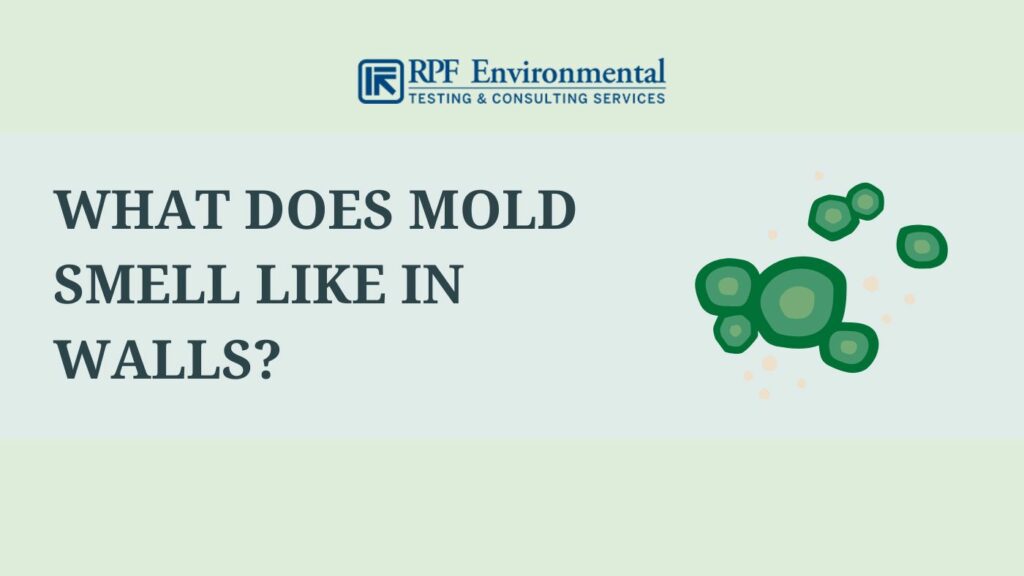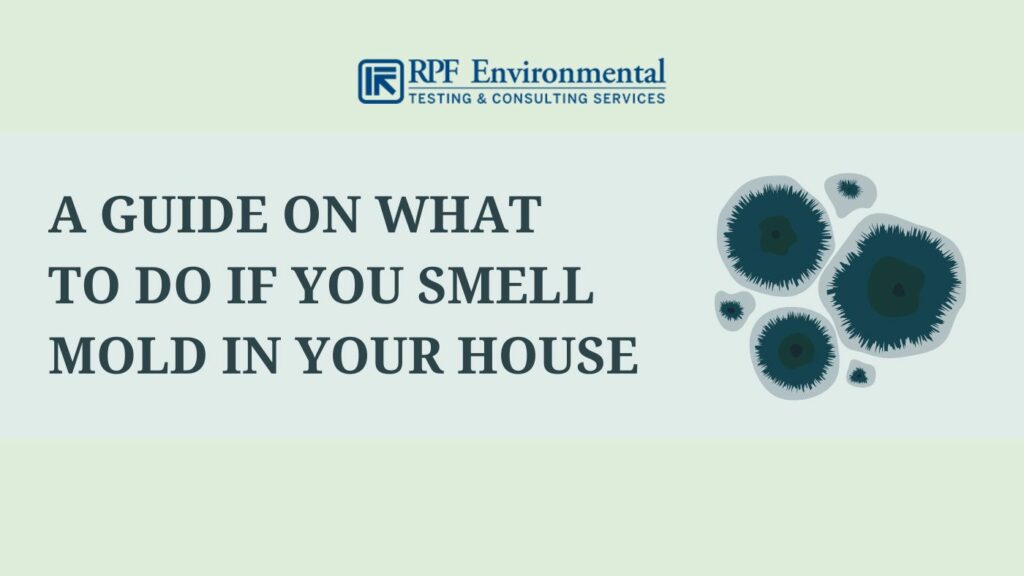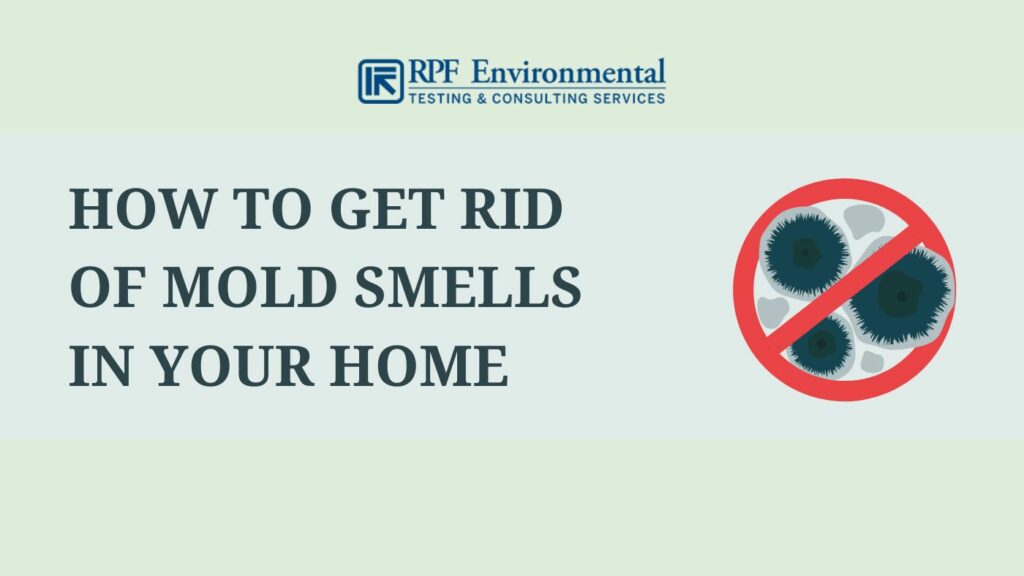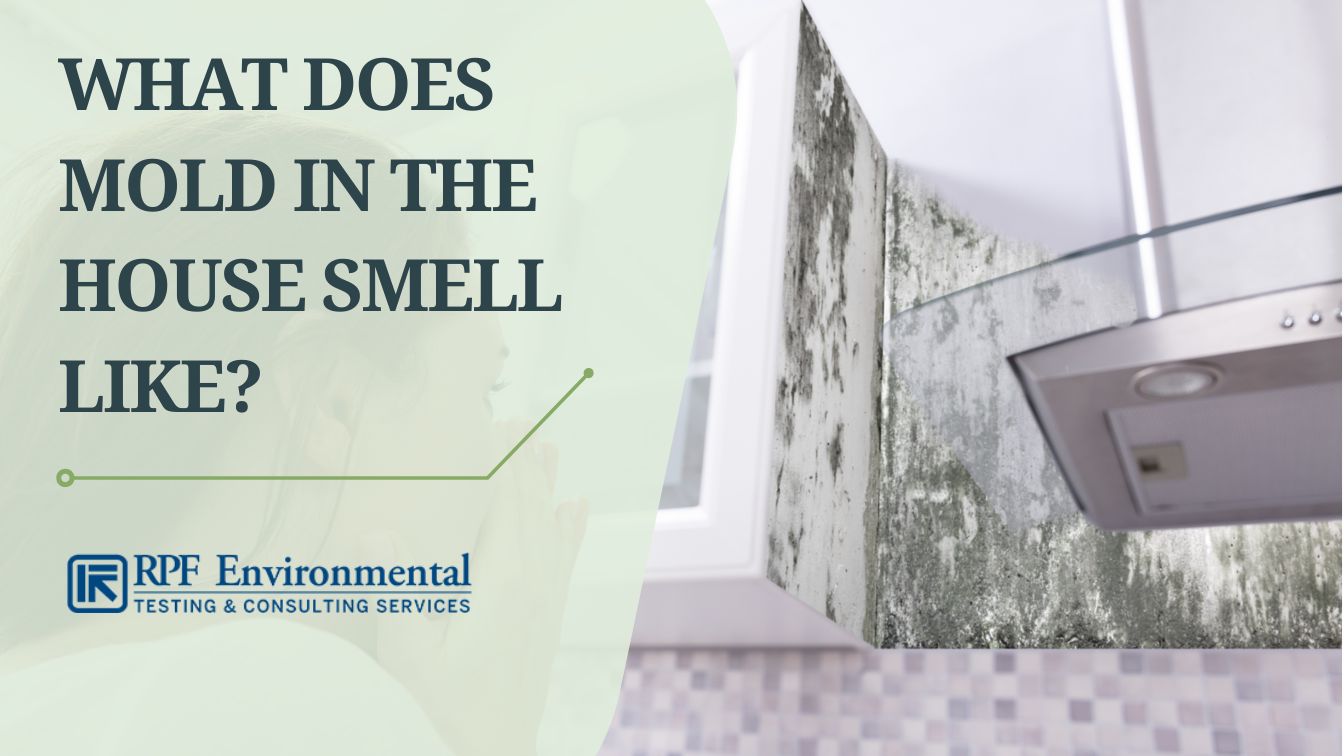Are you a homeowner who has noticed an unpleasant musty smell in your home? It could be the result of mold growing somewhere in your house. This can be a scary and overwhelming situation, but don’t panic!
Here, we’ll discuss what mold in the house smells like, its potential causes and health risks, and what you can do to get rid of mold smells. Thus, allowing you to detect and deal with possible mold infestations earlier to maintain a clean and healthy environment for your family.

RPF Environmental can help you detect mold in your home through our professional mold testing services. We serve various clients in the Nationwide including New Hampshire, Maine, and Massachusetts. Contact us now!
What Does House Mold Smell Like?
Homeowners describe the smell of mold differently: musty, sour, earthy, smells like sweaty socks or rotten meat, and others:
1. Musty Smell
A musty smell is a damp and stale smell. Others describe it as similar to the smell of garbage or decay that is common in basements or bathrooms and other damp and dark areas. This is because mold thrives in moisture.
Also, a musty smell is among the early signs of mold infestation in your home. You’ll start to smell it within 24 hours after mold spores have started to form. (Once lingering spores in the air find their way into damp surfaces, the mold will begin to spread.)
2. Sour/Tangy Smell of Fermenting Alcohol
Instead of natural scents, some mold species can also produce alcohol-type smells like that of the sour scent of fermenting alcohol. Other times, mold can also smell sweet.
3. Earthy/Rotting Wood Scent
For homeowners who love spending their time in the woods to camp or hike, they may describe the smell of mold in their house as rotting wood.
4. Other Smells
Once the mold colonies spread and the infestation becomes worse, you may smell stronger scents like the smell of sweaty or wet socks, rotten meat, or something pungent.
NOTE: The Smell Varies Between Different Types of Mold & Other Factors
The smell of mold in your home will vary depending on the following:
- Type of mold
- Growth stage of the mold
For instance, black mold species smell earthy and musty and sometimes smell like decaying plants or vegetables. Also, new mold growth will smell less pungent.
However, the same species of mold can also smell different depending on the condition of the environment where the mold is growing. The smell can also be affected by:
- Food sources
- Moisture levels
- Cohabitation with other microorganisms
Most molds have a musty/damp scent. But if the smell is different like sweaty socks or rotten meat, the mold must be cohabitating with other bacteria.
What Does Mold Smell Like in Walls?

If you smell mold but can’t find where it is coming from, it might be growing in hidden areas like those growing in a wall cavity. Mold in walls can smell musty, stale, and meaty, especially if you are dealing with toxic black molds. Even if the room is properly ventilated, the air will still smell different due to the hidden molds in your walls.
If you notice a mold-like smell in your home, better have a professional mold testing company, like RPF Environmental, help you verify the presence of mold infestation. We can find even hidden molds in your home and assist you in planning out your mold remediation process.
What Causes the Musty Smell of Mold?
According to EPA, the musty smell of mold is caused by some of the compounds they produce. In fact, the mold itself doesn’t smell bad, so it is not the mold that you are smelling. As molds grow and reproduce, they emit microbial volatile organic compounds (mVOCs) which have unpleasant odors. These strong-smelling compounds are what are affecting the quality of the air in your home.
Mold Odor Health Concerns: What Happens Once You Inhale Mold?
If you inhale mold spores, you’ll be experiencing allergic reactions that include the following symptoms:
- Coughing
- Sneezing
- Runny nose
- Headaches
- Irritated eyes
- Skin rash
- Itchy throat
- Nausea
- Dizziness
- Fatigue
Even if you are a healthy person, long-term exposure to mold can harm your health. In addition, sensitive and immunocompromised individuals will experience more serious health complications like asthma attacks, difficulty breathing, and lung infections. Thus, it is important that you seek medical attention if you are experiencing the mentioned symptoms.
Step-By-Step Guide: What to Do if You Smell Mold in Your House

Finding where the smell is coming from is the first step you need to do once you start to notice a moldy smell in your home. If you can’t find the mold, better work with a mold inspection company. After that, professional remediation is recommended to ensure the complete removal of the infestation.
Step 1. Find the Source of the Moldy Smell
Find the location of the mold growth by identifying where the smell is strongest. Make sure that you wear a respirator or mask and gloves to protect yourself.
Checking for spots, leaks, and other moisture sources would be your first step in locating them. Check our blog about places where you can find mold in homes here to help you with this step.
Note: The presence of a moldy smell in your house doesn’t always indicate mold infestation. If you can’t find where the smell is coming from, check for rotting food items, wet laundry, and other potential sources of the odor first. Also, open your windows to air out the area. If you have dealt with these other sources but the smell is still there, proceed to the next step.
Step 2. Consult a Professional Mold and Air Quality Testing Company to Verify the Presence of Mold In Your Home
If you want a more accurate assessment of the moldy odor in your home, we recommend hiring a certified mold testing company. RPF Environmental has the latest technology and experience to accurately and effectively assess mold infestation in your house.
Step 3. Assess the Mold Problem
Assess how severe the mold growth is. If it is less than 10 square feet, you can easily clean it up yourself through proper remediation.
NOTE: Improper mold remediation can cause the mold to grow back and make the problem worse. Don’t do it yourself if you are uncertain how to do it properly. Read more on our blog about cleaning up mold yourself.
Step 4. Eliminate the Mold
Remove the mold as soon as possible before the infestation spreads further. Or else, the smell will become stronger and the remediation process more difficult. You can’t do DIY remediation once the infestation gets worse.
Also, take note that some mold species are more dangerous than others. So if you are not sure how to deal with the problem yourself, it is safer to hire a professional.
Step 5. Fix Moisture Issues
You should not only remove the mold. Make sure to also fix sources of moisture to prevent mold from coming back. Leakages and water damage, like previous flooding, are often among the main reasons for mold growth.
How to Get Rid of Mold Smells in Your Home

You can use odor absorbers. But, the only way to completely get rid of the smell of mold in your home is to remove the source of the problem through mold remediation. Mold remediation involves removing and cleaning contaminated areas in your home using specialized equipment. You can do this yourself for small mold colonies, but you should leave large infestations and complex removals to a professional.
FAQs
Mold will smell musty and stale. But if the mold has been growing in your home for a long time, the smell will be stronger like how sweaty socks or rotten meat smell. You can also buy a home-test kit for molds, but these are not guaranteed to give you accurate measurements of airborne particles.
Smelling mold can cause mild to severe reactions, especially for individuals with existing respiratory conditions. These include nausea, fatigue, headaches, dizziness, and irritation of the airways. Consult a medical professional if you are experiencing these symptoms and get rid of the mold as soon as possible.
If you weren’t able to identify where the moldy smell is coming from, the mold might be growing in hidden areas like ducts, air vents, HVAC, attics, or walls. Check humid and damp areas in your home where mold might be hiding. If these methods fail, consult a professional to inspect your home for mold contamination. RPF Environmental can identify the type of mold and guide you on how to deal with mold infestations effectively.
Using odor eliminators won’t completely kill the smell of mold in your home. Mold remediation is the only way you can get rid of the smell permanently. Work with a certified mold remediation company to ensure the effective removal of mold instead of doing it yourself.
Conclusion
The smell of mold in your home will depend on the type of mold and the environmental conditions where it is growing. But in general, they have a musty and earthy smell. However, take note that not all moldy smells signify mold infestation. You need to have your home inspected by a professional first before ripping your wall or carpet apart.
Reach out to RPF Environmental for professional mold inspection and testing services. You can trust our years of experience in indoor air quality and mold inspection. We serve clients across the country.




